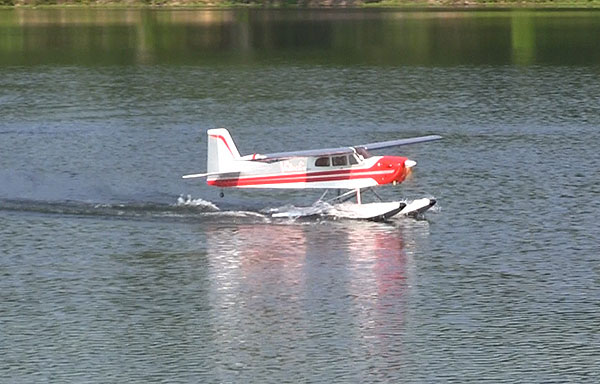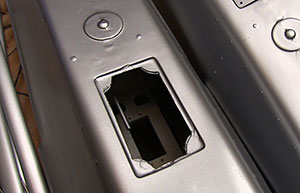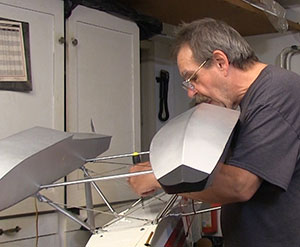



When I decided to try flying off water there was only one plane I thought of, my
Valiant. The Hangar 9 1/4-scale floats fit it perfectly.
Text, photos and video by Tom Hintz
Flight/Water Video by Clark Ponthier
Posted – 7-24-2017
When I noticed an upcoming float fly near me I remembered seeing a float set that is compatible with my Hangar 9 Valiant. I’ve not flown off water before but suspected the gentle characteristics of the Hangar 9 Valiant would make this new adventure fun.
The Hangar 9 Quarter-Scale Floats (HAN4580) are fabricated from fiberglass to give them the strength and light weight necessary for an RC plane. While molding they included scale rivets, panel lines and contours as well as a very nice, scale-looking strut system that keeps these floats in place on the water and in the air.
The contours of the floats help keep the Hangar 9 Valiant tracking predictably on the water during take-off and landing. To steer the Hangar 9 Valiant the designers included a dual rudder system that works way better than a blast of prop wash on the rudder. Much like the full-scale float rudders the versions on the Hangar 9 Quarter-Scale Floats are spring-loaded so they can flip up to prevent damage should they hit debris in the water.
Each float has 5 simulated and one (forward) functional top hatch. The operating hatch allows us to hide any weight needed inside of the float to get the CG correct for the plane. In addition to what I thought would be obvious aerodynamic changes, the weight of Hangar 9 Quarter-Scale Floats makes balancing the Hangar 9 Valiant after their installation a critical task. I want to have fun, not stuff my prized Hangar 9 Quarter-Scale Floats into the lake.
All the hardware appears to be stainless steel and all of it cleanly manufactured. Too many plane kits come with the cheapest hardware known to man and all the frustration that can induce. With the Hangar 9 Quarter-Scale Floats the hardware will not be of concern after being exposed to (fresh) water.

These floats use a servo-driven rudder
on each float so handling in the water
is better than most.
Assembling something like the Hangar 9 Quarter-Scale Floats is a bit complicated because of structure that keeps them steady and supports the plane. I suppose to engineering types all the pieces and their angles make perfect sense. To the rest of us there will be some trial and error even with the text and photos provided in the instruction manual. I have written and edited instruction manuals for decades and short of a full-length, show-it-all video, I think Hangar 9 has done as best as can be expected.
I did get everything assembled in one day except for making the sealant gaskets for the servo bays and the necessary overnight curing time. Throughout the assembly I was watching for weak points or other possible trouble-prone areas but found none. Since I am not experienced with flying off water I may have a few slightly aggressive landings. I have full confidence in the durability of the Hangar 9 Quarter-Scale Floats and expect them will make this new experience fun.
I had hoped to use a mix in the transmitter so I could better control the twin rudders on the Hangar 9 Quarter-Scale Floats if they proved to be more sensitive than I was comfortable with. But, I did not have an open channel with which to create a mix so decided to use a simple Y-cord off the Rudder channel, plug the rudder servo into one side of the Y-cord and a second Y-cord into the other side to connect to the servos in the floats. That proved to be a very workable solution.
The Hangar 9 Quarter-Scale Floats were originally designed for the Hangar 9 Cub and the Hangar 9 Valiant also has factory-installed mounting points to use this float set. While there is no mention of the Hangar 9 Valiant installation in the float instructions, the floats are covered in the Hangar 9 Valiant instructions. No mention is made of altering the original Hangar 9 Valiant CG point of 4-1/2” back from the leading edge so I checked the float-equipped CG of the Hangar 9 Valiant at that point and found the CG was unchanged. This surprised me and I kept that concern in the back of my mind so I would watch for a change in handling.

Mounting the assembled floats the first
time took a little while but it goes quick
the next time.
I chose a Float Fly In, held at another local club, the Smith Lake Flyers, for my first float flying experience. The Smith Lake Flyers have access to a beautiful lake from which to fly. I wasn’t’ worried about how the floats would perform as I have seen many sets in action in the past. But, I had never flown them myself so I was the biggest concern for me and my prized Hangar 9 Valiant, one of my all-time favorite planes.
After getting the Hangar 9 Valiant started and in the water, I taxied out, pointed it sort of into the light wind and gassed it. The Hangar 9 Valiant is a big plane and I wondered if it would wallow around but it seemed to pick up speed quickly, the plane got “up on the floats” and it lifted off with a little elevator encouragement.
The biggest surprise is how little the Hangar 9 Quarter-Scale Floats impacted the flight characteristics of the Hangar 9 Valiant. It had a tiny bit more of a sink rate than normal when I came in to do some touch (splash?)-and-go’s but with a little added power it came in nicely with full control.
Another pleasant surprise was how well the twin rudders on the floats worked. Even though I had to slave them of the main rudder I never felt like they were over or under steering. Be gentle with the rudder when the plane was building or at speed in the water and all is fine. With the engine at water-taxi rpm the rudders worked fine and I could drive the Hangar 9 Valiant where I needed it to go.
Touch and goes were also surprisingly easy. I love doing touch and goes with the Hangar 9 Valiant and the floats made doing that on water nearly as simple as on the grass. Naturally, water has way more resistance than does grass so the Hangar 9 Valiant needed a bit more power and a slightly longer takeoff run but that is totally manageable. A couple minutes into my maiden float flight and I was happily doing my touch and goes.
Early into a subsequent flight I had taken off and made most of a circle around the lake when the Hangar 9 Valiant pitched up violently and began going through what appeared to be wild control surface gyrations. For the first time since the 1980’s I felt like I was in the midst of a radio failure.
I will go into detail about this “incident” in a separate story since the Hangar 9 Quarter-Scale Floats had no role in what happened. In fact, they may have saved me an engine and some servos. In the end, I never regained control and the Hangar 9 Valiant crashed with only the engine and some servos surviving. My prized Hangar 9 Valiant was a gonner as were the floats that I had suddenly come to enjoy flying with. Again, the floats were in no way responsible for what I firmly believe was a simple, rare but devastating receiver failure.
Though a little complicated to assemble the Hangar 9 Quarter-Scale Floats proved to be surprisingly easy to fly with. They do add some weight to the overall airframe but the Hangar 9 Valiant didn’t seem to care much at all. I had to add a couple clicks of up elevator trim but that was all it needed. You can tell that water does have way more drag than grass on takeoff but the DLE40 Twin in my Hangar 9 Valiant pulled it into the sky easily.
With a street price of $279.99 (7-16-2017) the Hangar 9 Valiant floats certainly are not cheap but for the quality and necessary size to handle this large of an airframe I think the cost is more than reasonable. The floats track very well in the water and the included dual rudder system made “driving” the Hangar 9 Valiant around the lake much easier than I was seeing with other float designs.
Though my first day on floats ended badly the floats had nothing to do with that but everything to do with a very enjoyable and fun float flying maiden experience. This water-flying thing I can be lots of fun as evidenced by what looked to be over 40 pilots at my first float fly.
I must say that the Smith Lake Flyers (link in Resources below) not only put on a great float fly, their members went out of their way to help me when my Hangar 9 Valiant went down. The Smith Lake Flyers membership are precisely the kind of people that make RC flying such an enjoyable hobby. They are having another float fly later this year and I told a few of their members that would do whatever I could to be there, with a float-equipped plane for that event. Flying off water is lots of fun and this is a very friendly club to fly with. I can’t let the crash of my Hangar 9 Valiant stop me from enjoying folks like the Smith Lake Flyers or another aspect of the hobby I love and is helping my fight against Alzheimer's.
Visit the Hangar 9 Quarter-Scale Floats web page – Click Here
Have a comment on this Review? –Email Me!